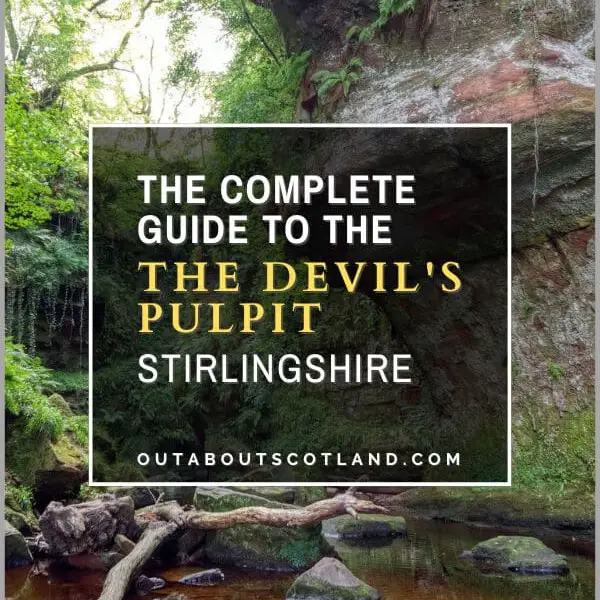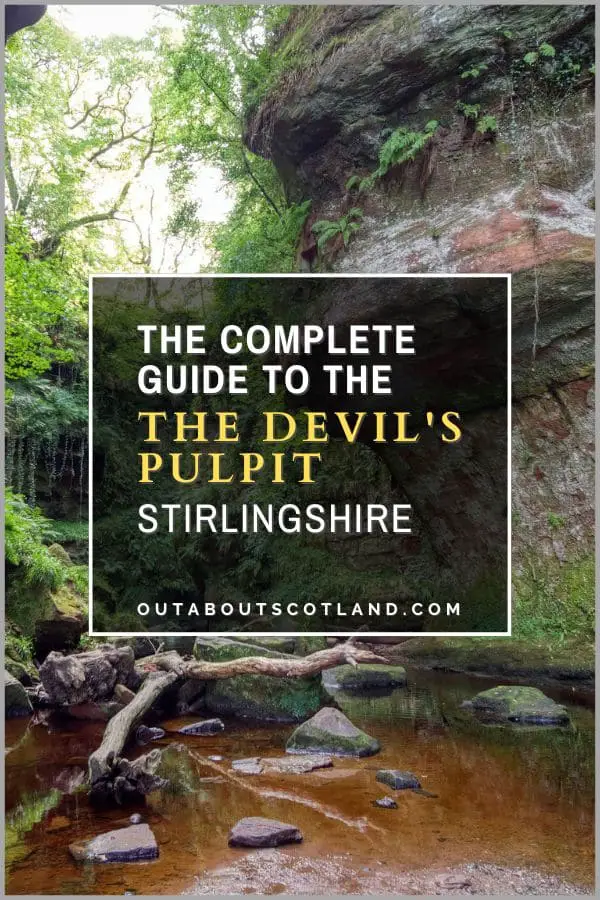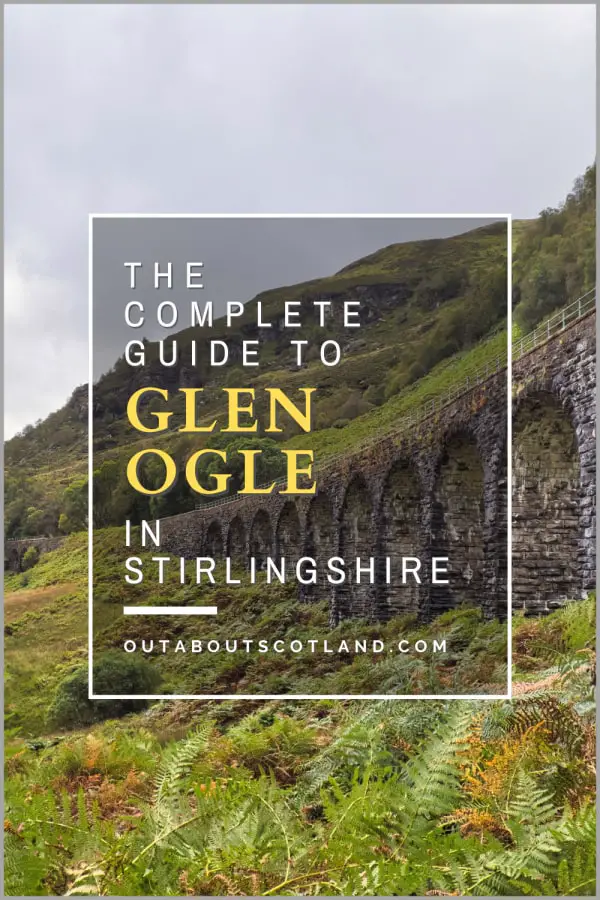The Devil’s Pulpit is a deep sandstone gorge hidden amongst the woodland and rolling fields of Finnich Glen in Stirlingshire, around 14 miles north of Glasgow. This geological curiosity earned its name from an unusual rock outcrop that legend says was the site of sermons given by the devil, perhaps inspired by the fact that the swirling waters beneath it are blood red in colour.
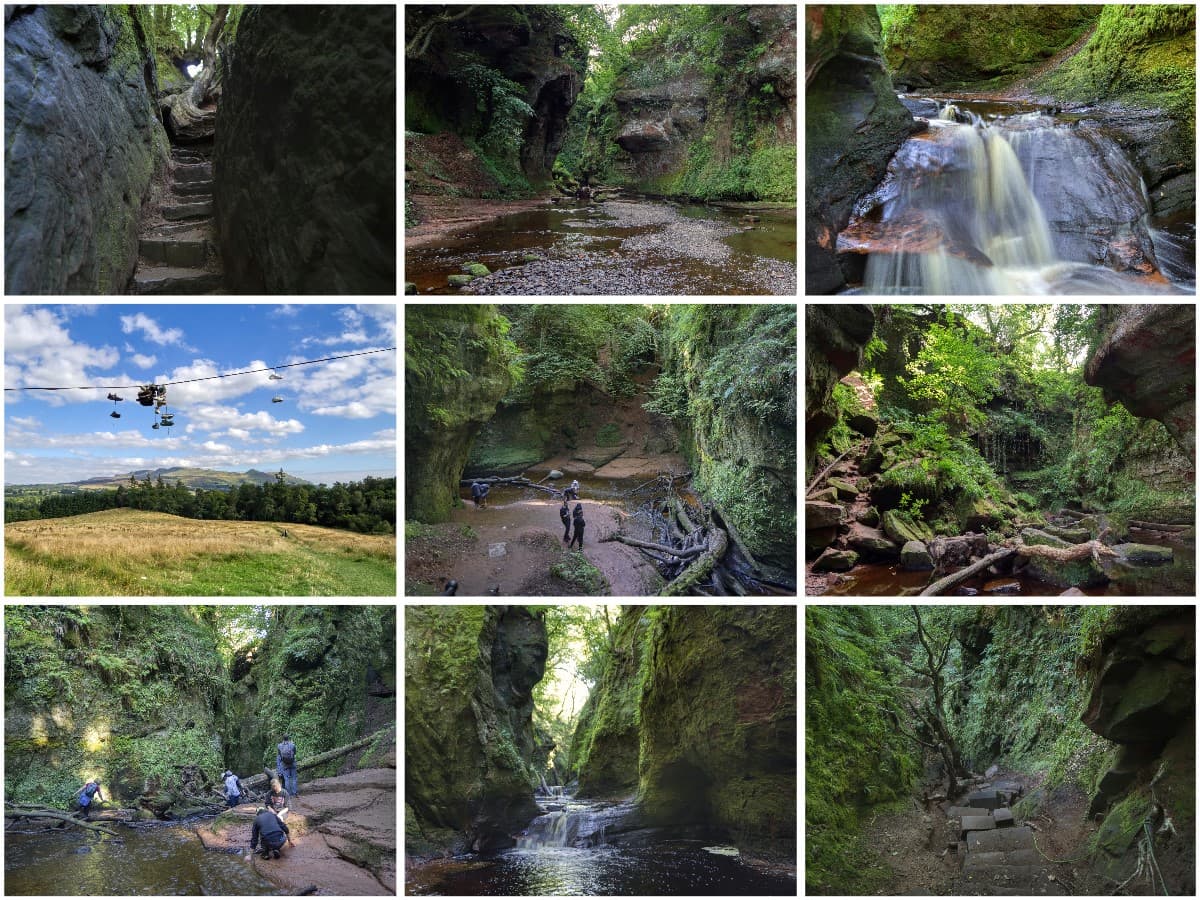
| Address: | Glasgow, G63 9QJ |
| Opening Hours: | The Devil's Pulpit is accessible 24/7, 365 days a year. |
| Admission Price: | N/A |
| Parking: | There is free car parking at the junction of the A809 and B834 with room for approx 10 cars. An additional parking area is located in a layby opposite the start of the Devil's Pulpit path on the A809. The A809 and B834 have double yellow lines for approx 1 mile around Finnich Glen. |
| Contact: | N/A |
| Facilities: | There are no visitor facilities at Finnich Glen. |
| Photos: | Virtual Tour |
Overview
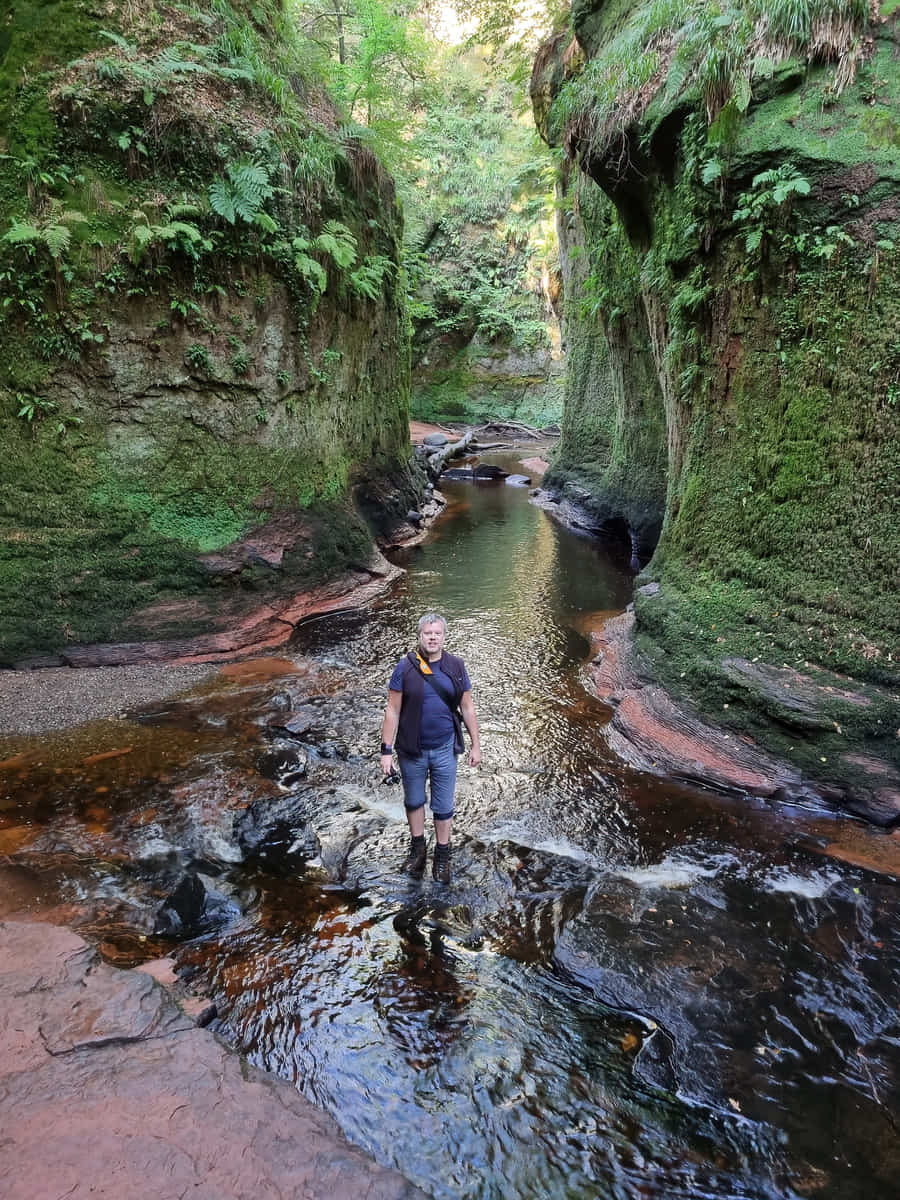
The Devil’s Pulpit, located just south of Drymen and north of Craighat, is a captivating, 100-foot-deep gorge that’s famous for its moss-covered sandstone walls and blood-red waters. Steeped in myth, it’s said to be a place of worship for the devil, hence its name. A true hidden gem, the Devil’s Pulpit offers a unique, mystical experience for adventurous hikers and Outlander fans alike.
If you’ve ever seen the TV show Outlander then you’ll probably remember the episode in season one where Dougall MacKenzie drags poor Claire to the Liar’s Spring – a magical fountain with waters that are poison to anyone that speaks untruths.
The spring is set in a red-walled canyon that looks like it has come straight out of a Lord of the Rings movie set, but it is, in fact, the Devil’s Pulpit which is located off the not-so-magical A809 14 miles north of Glasgow.
The name given to this natural attraction is often used to describe the entire 1,000-foot gorge that shrouds the Carnock Burn, but that’s actually incorrect. The Devil’s Pulpit is, instead, a bizarre mushroom-shaped rock located in one area of the winding gully, while the surrounding depression is correctly named Finnich Glen.
The glen is a genuinely beautiful place with sheer-sided red sandstone walls that tower 100 feet overhead in places with walls that are covered by thick green mosses. A canopy of trees in the surrounding woodland covers much of the sky, so it’s rather dim down there, but when the sun shines through, there’s enough light to see the water turn a deep blood-red colour as the sun reflects off the underlying sandstone.
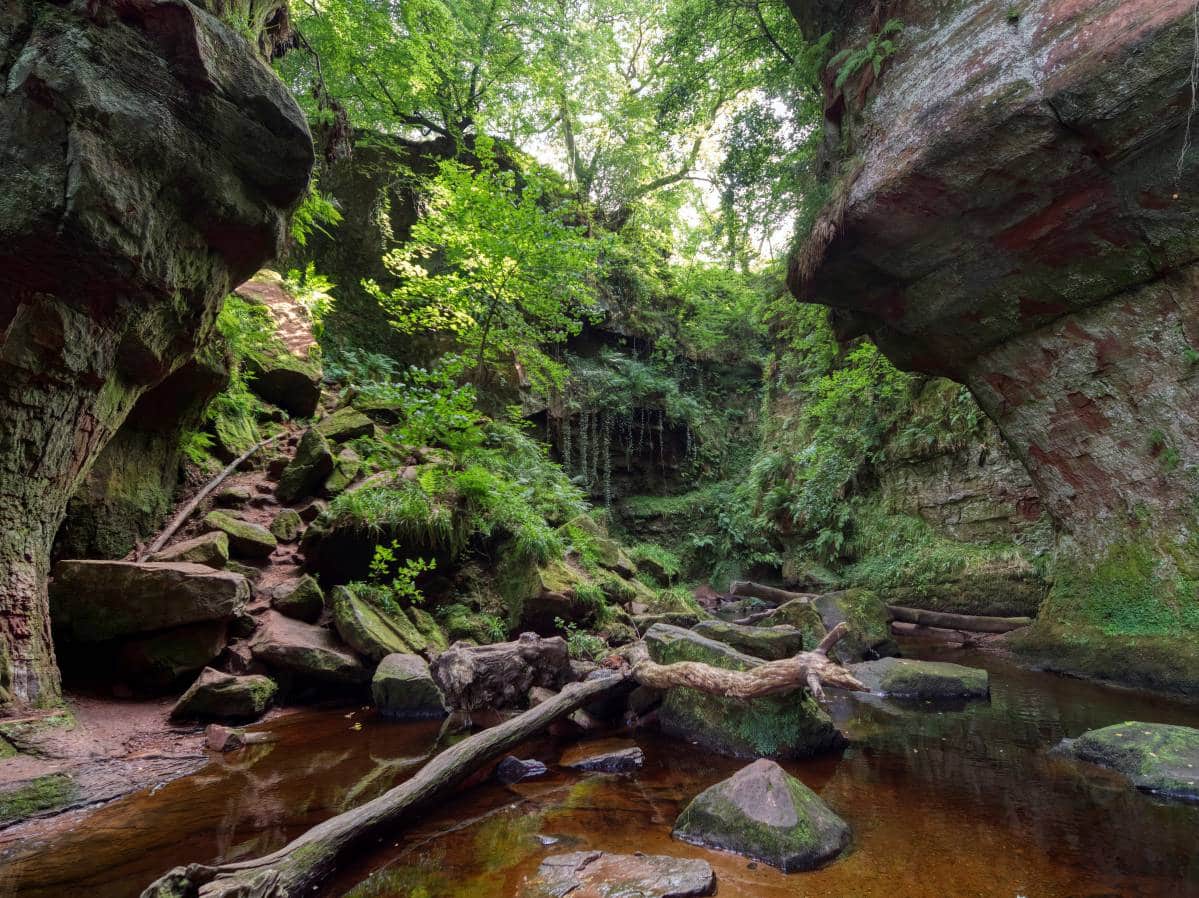
It’s quite a sight and it has an otherworldly feel that rivals the equally bizarre Fairy Glen on the Isle of Skye in my opinion. According to one legend, the Devil’s Pulpit got its name when he used the rock to preach to his followers, while according to another, Druids and witches used it to perform magical spells and rituals.
However, a more likely story is that the bloody colour of the water inspired the spooky tales in order to keep unwary travellers away from the sheer rock faces that are extremely difficult to see through the thick undergrowth of the woodland.
Even in recent years, there have been deaths caused by people plummeting down into the gorge, so keep that thought in mind when you visit. Personally, I’d keep dogs on a lead and keep a very watchful eye on children.
The path to Jacob’s Ladder might be well-trodden, but the entire site is privately owned and is not set up in any way as a tourist attraction. This latter point means there are absolutely no facilities, no bins (sadly, there’s a lot of litter left behind by people too lazy to take their rubbish back home with them), and no safety barriers.
To be fair, there are danger signs at the entrances, and there’s a low wire fence around most of the gorge, but the fence has been stamped flat in a number of places, and there are no direction signs to tell you which way to go.
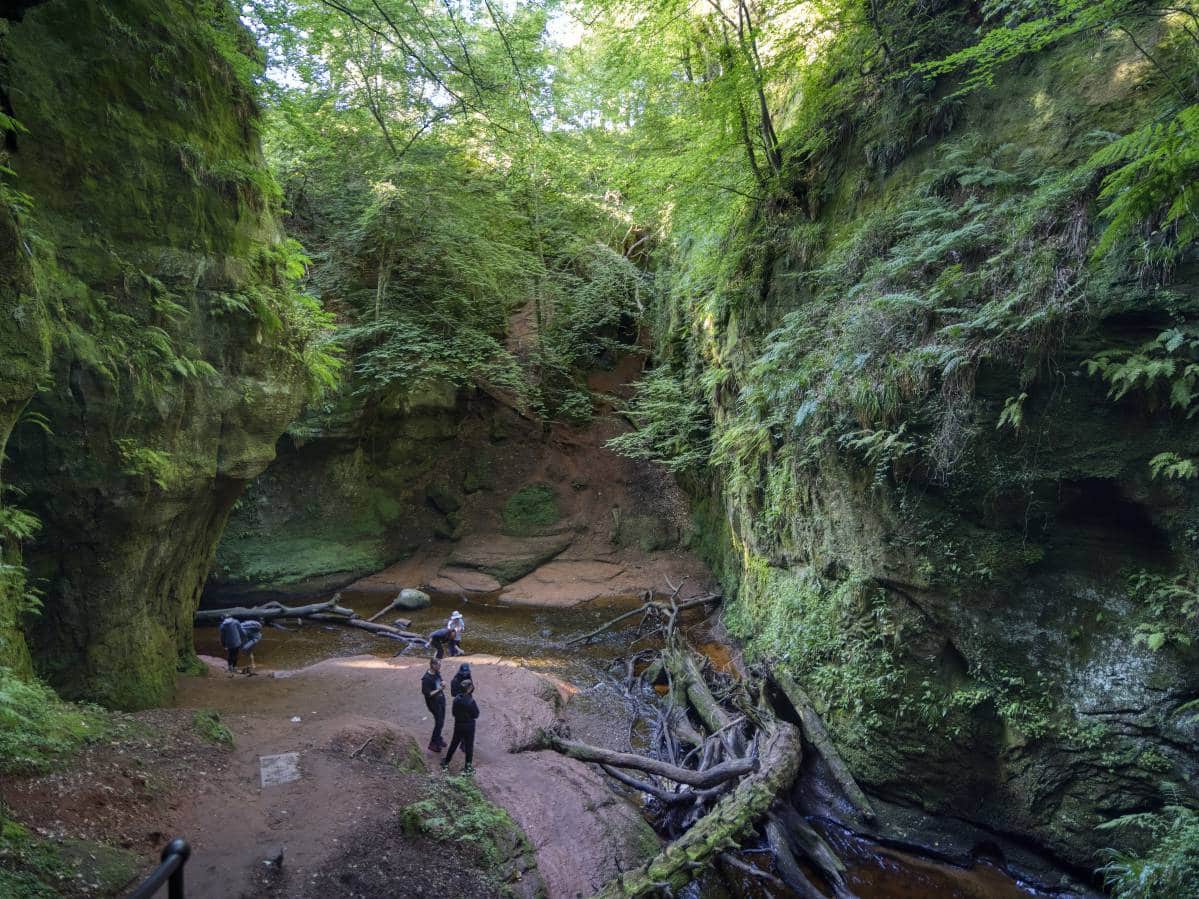
The Highlights
1: Even without the legend of the devil’s supernatural sermons, this is an incredibly atmospheric place. Splashing through the blood-red waters of the gorge as the sun casts its final rays of the day is spine-tingling stuff.
2: This not-so-secret hidden gorge is a great place to visit if you’ve been to Loch Lomond and have an hour or two to spare. Balloch to the Devil’s Pulpit is only a 9-mile drive which shouldn’t take more than 20 minutes.
3: If you’re after an Instagram-worthy selfie you’ll have plenty of opportunities to snap the perfect shot at the Devil’s Pulpit. It’s a very picturesque place (especially when the sun’s shining), but be mindful that it’s quite dimly lit at the bottom.
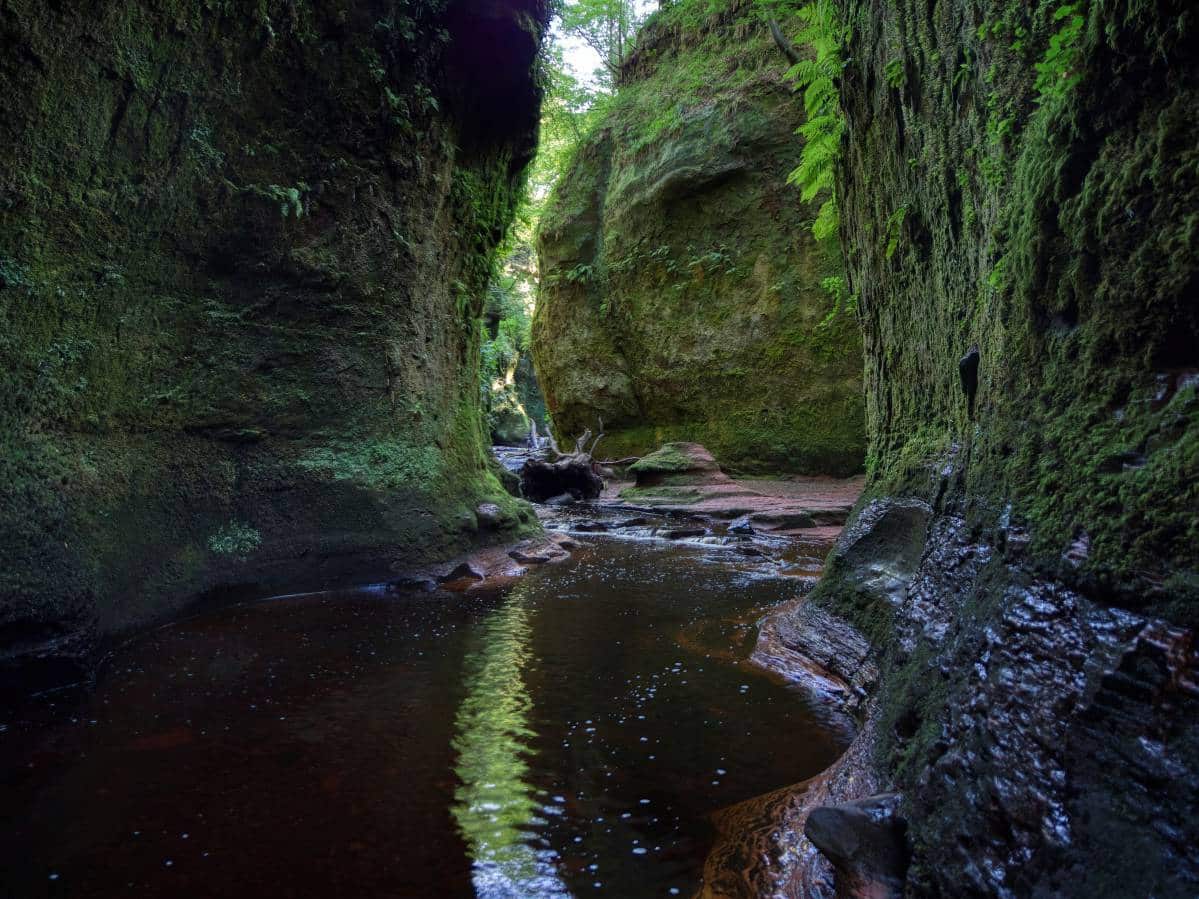
Visiting Tips
1: Getting to the Devil’s Pulpit can be tricky as the path through Finnich Glen from the roadside verge on the A809/B834 junction appears to lead nowhere. The best option is to park in the layby on the A809 and cross the road to a broken wall which marks the start of the footpath to Jacob’s Ladder (the main entrance to the Devil’s Pulpit). You’ll find a route map further down this page.
2: Be aware that the rough stone steps (Jacob’s Ladder) that lead down to the bottom of the gorge are very slippery when wet. There’s a rope ladder in place (usually) which helps tremendously, but it’s a difficult descent and is definitely not recommended for anyone with mobility problems – as can be seen in the news reports of serious accidents that occur virtually every year.
An easier route to the gorge leads into it from the opposite end (identified in the map further down this page), but getting to the Devil’s Pulpit from this approach requires crossing deep pools of water.
3: Parking is on a first-come, first-served basis, so I recommend getting there early as this natural attraction has exploded in popularity in recent years. The layby on the A809 only has 3–4 spaces, while the off-road area near the junction has around 10–15 spaces but requires walking along the road to get to the start of the footpath leading to Jacob’s Ladder.
Note that the roads in both directions have double yellow lines along them for around a mile, and fines for illegal parking are heavily enforced.
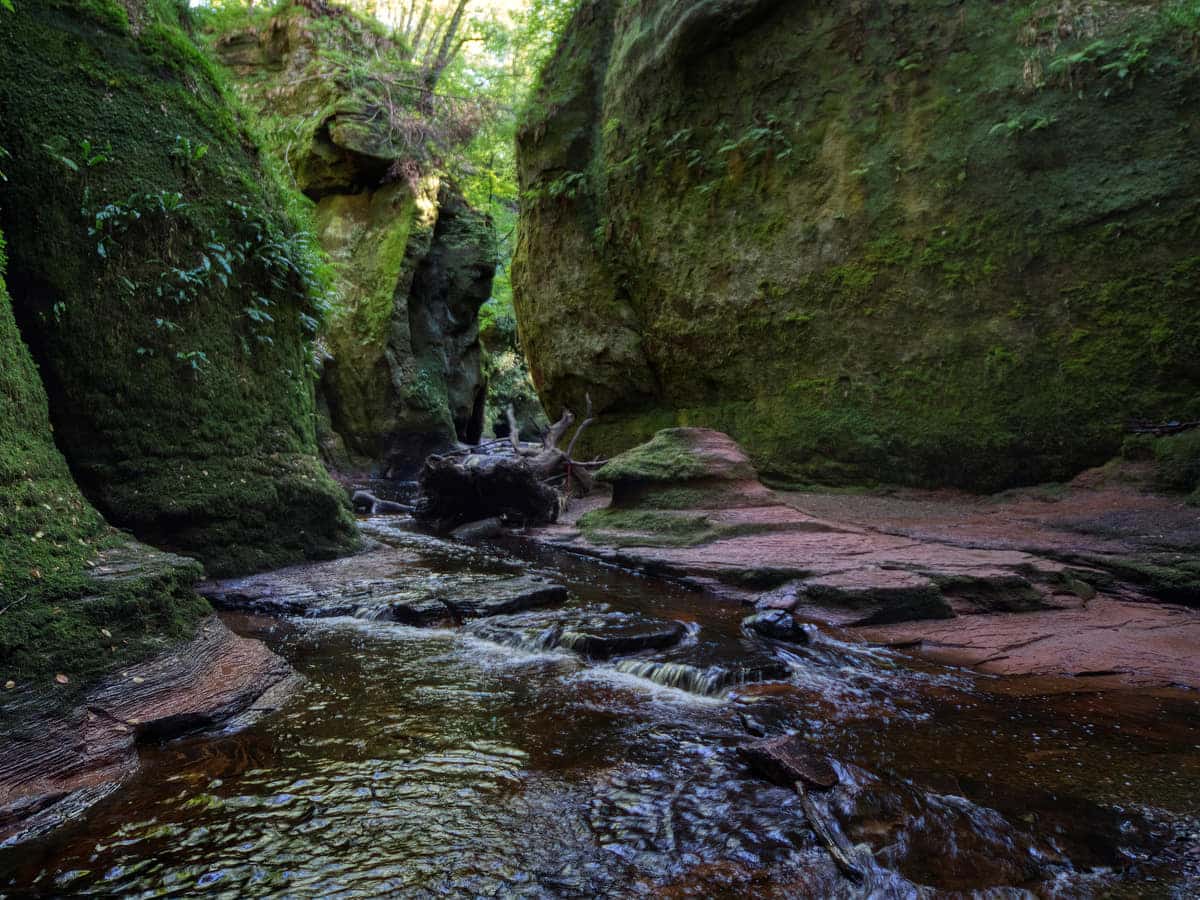
Tourist Information
If you’re reading this article with the intention of seeing the Devil’s Pulpit you have a couple of options for exploring the site.
The first is to approach it from the northeast end which has a gentle incline from a field into the Carnock Burn. From there you can splash your way along it through the many pools of the gorge before arriving at the famous rock. This is a route that’s easy to enter and exit, but it does require clambering over rocks and waterfalls as well as braving pools of water that can be waist-high after a good rainfall.
The second option (and the most fun) is to enter the pulpit’s chamber via Jacob’s Ladder – a very steep set of ramshackle rocks that’s definitely not for the faint-hearted and is downright dangerous when the rocks are wet.
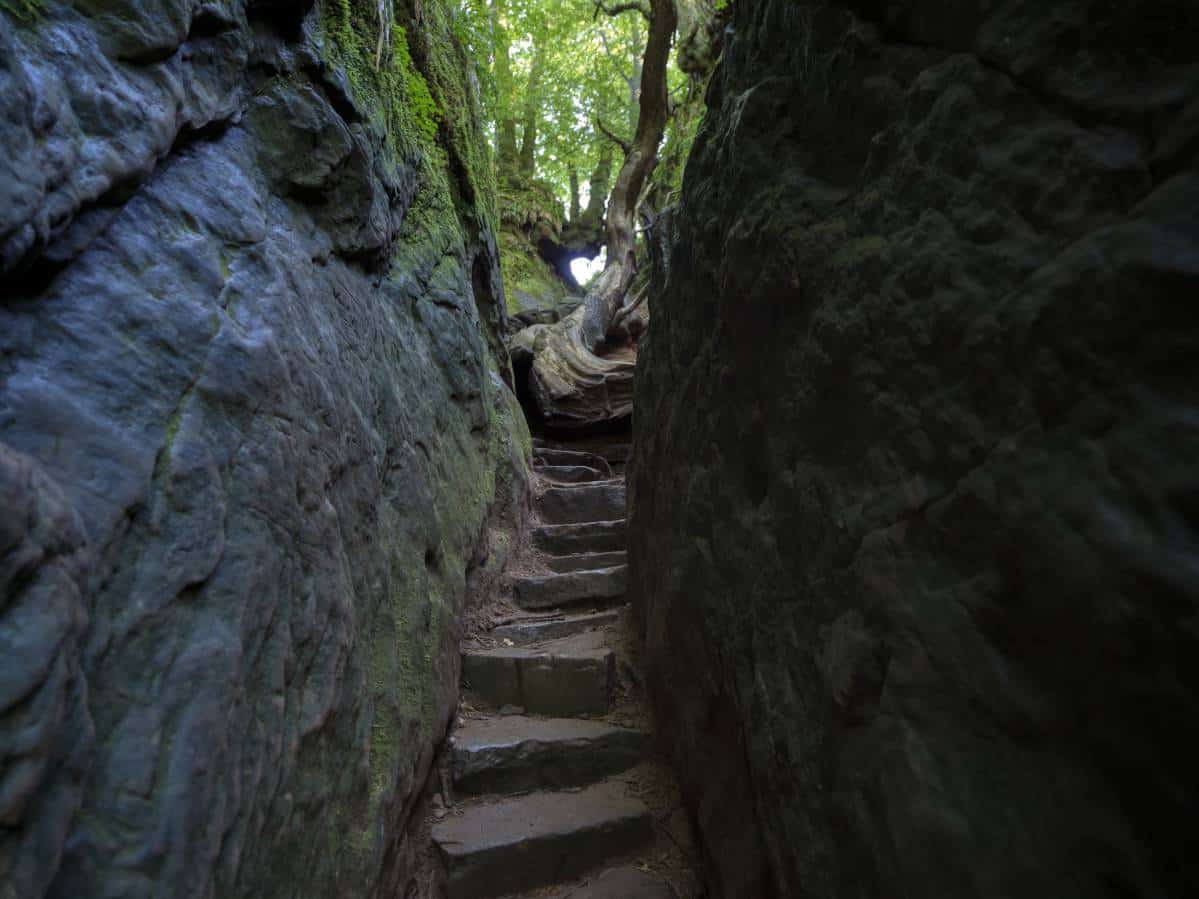
During my visit, I made good use of a rope that had been tied up along the length of the steps, but by all accounts, this rope is often missing. If you arrive and find that the rope isn’t there, then you might consider leaving Jacob’s Ladder for another time as it can be a dangerous descent.
If it’s dry and you’re fit and able, then I suggest exploring both areas of the gorge from the direction of the A809, first Jacob’s ladder and the Devil’s Pulpit, then clambering back up and walking down to the northeast entry point.
Both areas are very photo-worthy but as it’s so dark your camera may well struggle to take a good picture. If you take any kind of semi-pro camera then a tripod will come in very handy, especially for those silky shots of the waterfall. As scenic as it is, you’ll be hard-pushed to spend more than an hour at Finnich Glen, so it’s just as well that the area is chock-a-block full of other places to visit.
You’ll find a few suggestions further down this page but I personally recommend taking a look at Glengoyne Distillery, The Whangie (another geological wonder), and any of the trails around the Kilpatrick Hills such as the path that circles Burncrooks Reservoir.
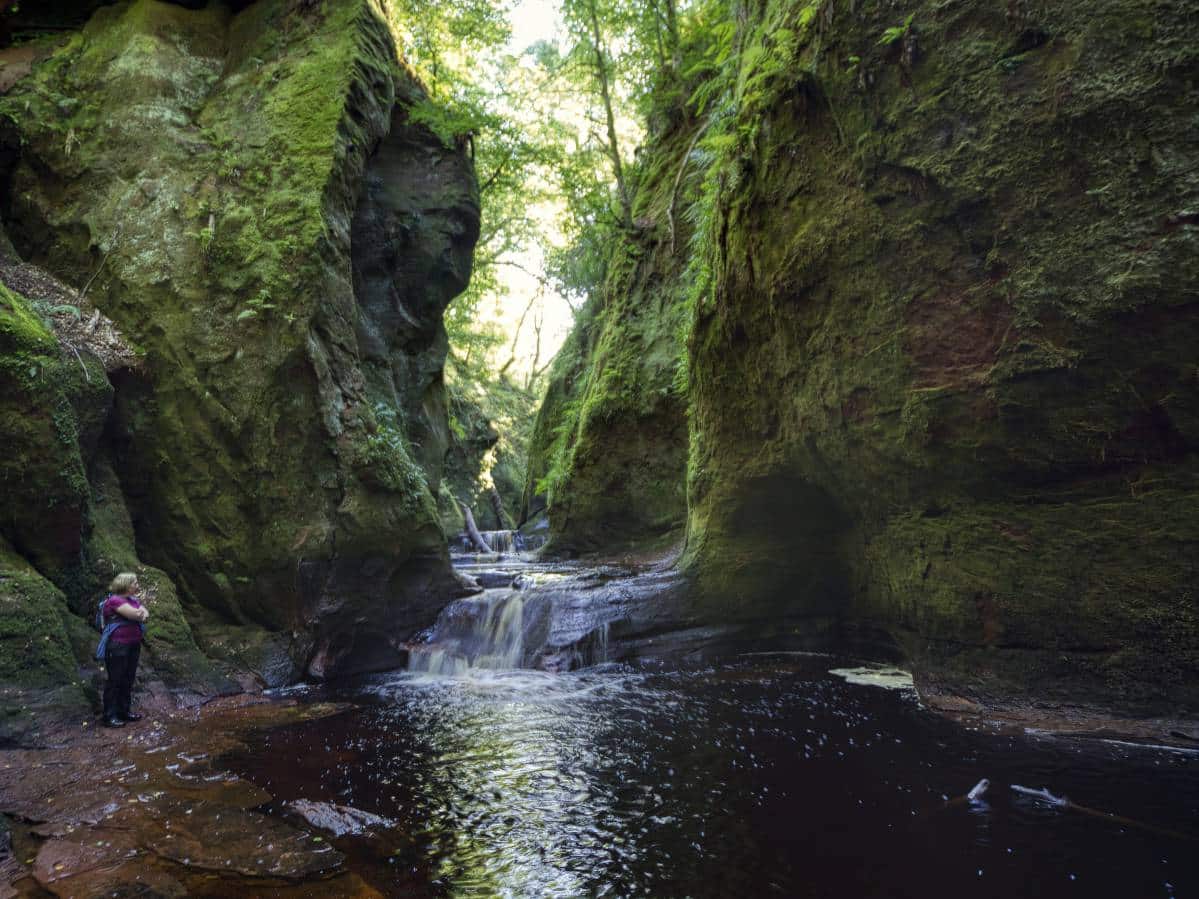
How to Get to the Devil’s Pulpit
For many years the Devil’s Pulpit was one of those hidden gems that most people heard of by word of mouth, but it’s now well and truly on the tourist map. In fact, since 2020 the site has become so busy the local council has (in their wisdom) completely double-yellow lined the roads leading to the site on both the B834 and the A809.
If you’re wondering where to park for the Devil’s Pulpit I’m afraid it’s now near-impossible at the weekend so your best bet is to either visit midweek or in the evening (summer only).
The best parking space is the layby opposite the start of the path to Jacob’s Ladder, but there’s only room for 3 or 4 cars. Another parking area can be found at the junction of the two roads (labelled on the map below) which has space for 10-15 cars.
If you have no option but to park on the rough area near the junction then I recommend following the well-trodden Devil’s Pulpit circular walk into Finnich Glen, veering back towards the A809, walking along the roadside verge (do this at your own risk), then follow the A809 till you reach the start of the Devil’s Pulpit path opposite the layby.
From there it’s a quick shimmy over a broken wall to the track across the field that leads to Jacob’s Ladder. It’s not really obvious where the steps are so I suggest asking someone coming back in the opposite direction to point the way. Hopefully, someone will install direction signs before too long.
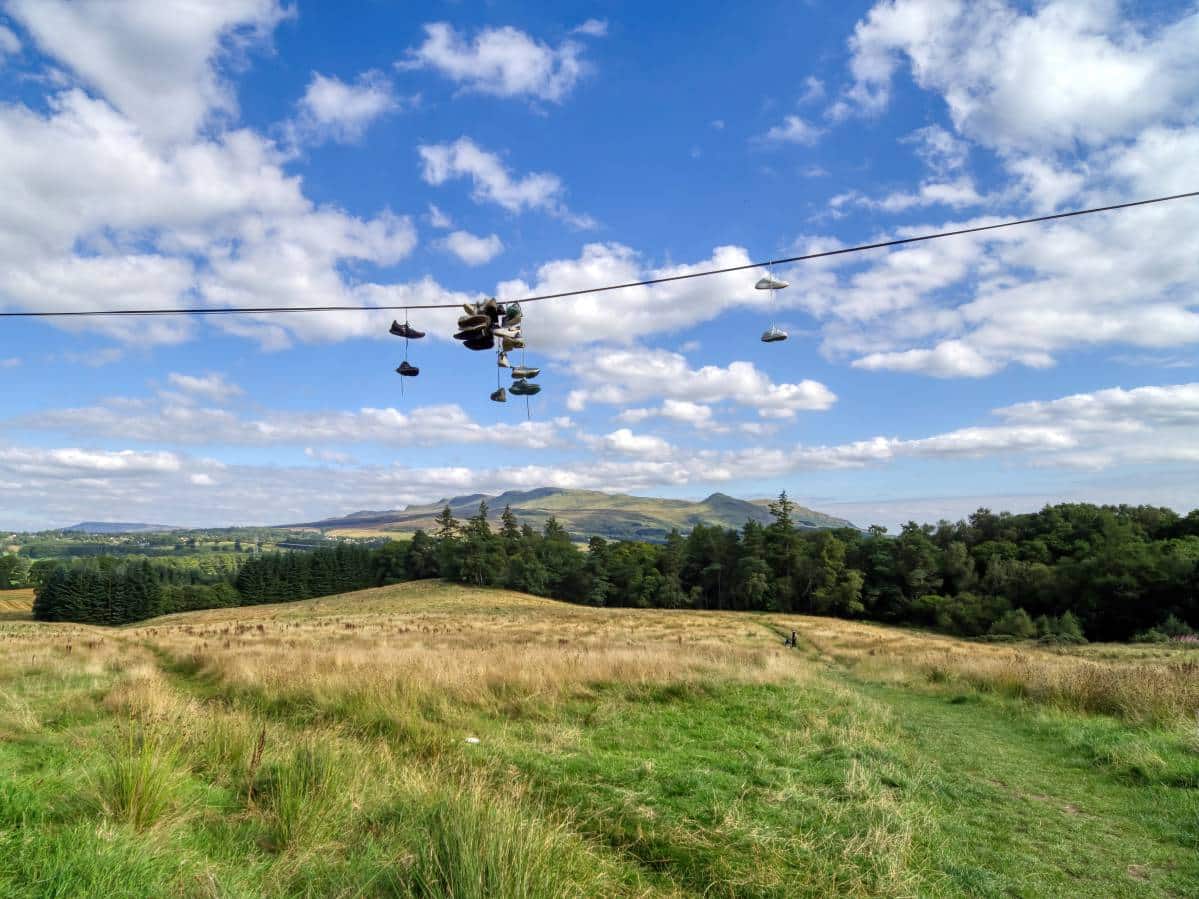
Things to Do
Exploring the Gorge: Finnich Glen, a mossy, 100-foot-deep gorge formed in red sandstone rock, has an enchanting and slightly eerie atmosphere that makes exploring it a unique experience. Navigating the bottom of the gorge is challenging due to the steep steps that lead to it, but the effort involved is more than worth it.
Photography: The Devil’s Pulpit is a photographer’s dream location. The crimson water, the lush greenery, and the sunlight filtering through the trees above create a perfect canvas. Capture the waterfalls tumbling over the rocks in the late evening for a truly memorable shot.
Picnicking: Enjoy a leisurely picnic on the higher grounds overlooking the gorge or towards the eastern end at the start of the Carnock Burn. Remember to leave no trace behind to preserve the natural beauty of the area.
Loch Lomond: The Devil’s Pulpit is just a 10-minute drive from RSPB Loch Lomond (address: High Wards Farm, Gartocharn, Alexandria, G83 8SB), which is a wonderful place for bird watchers to sit with a pair of binoculars (link to binocular reviews).
Folklore Exploration: Delve into Scottish folklore and mythology. The Devil’s Pulpit is said to be the place where the devil gave his sermons, hence the name. For those visitors who love the TV show, Outlander, taking a selfie in front of the ‘pulpit’ is a must-do.
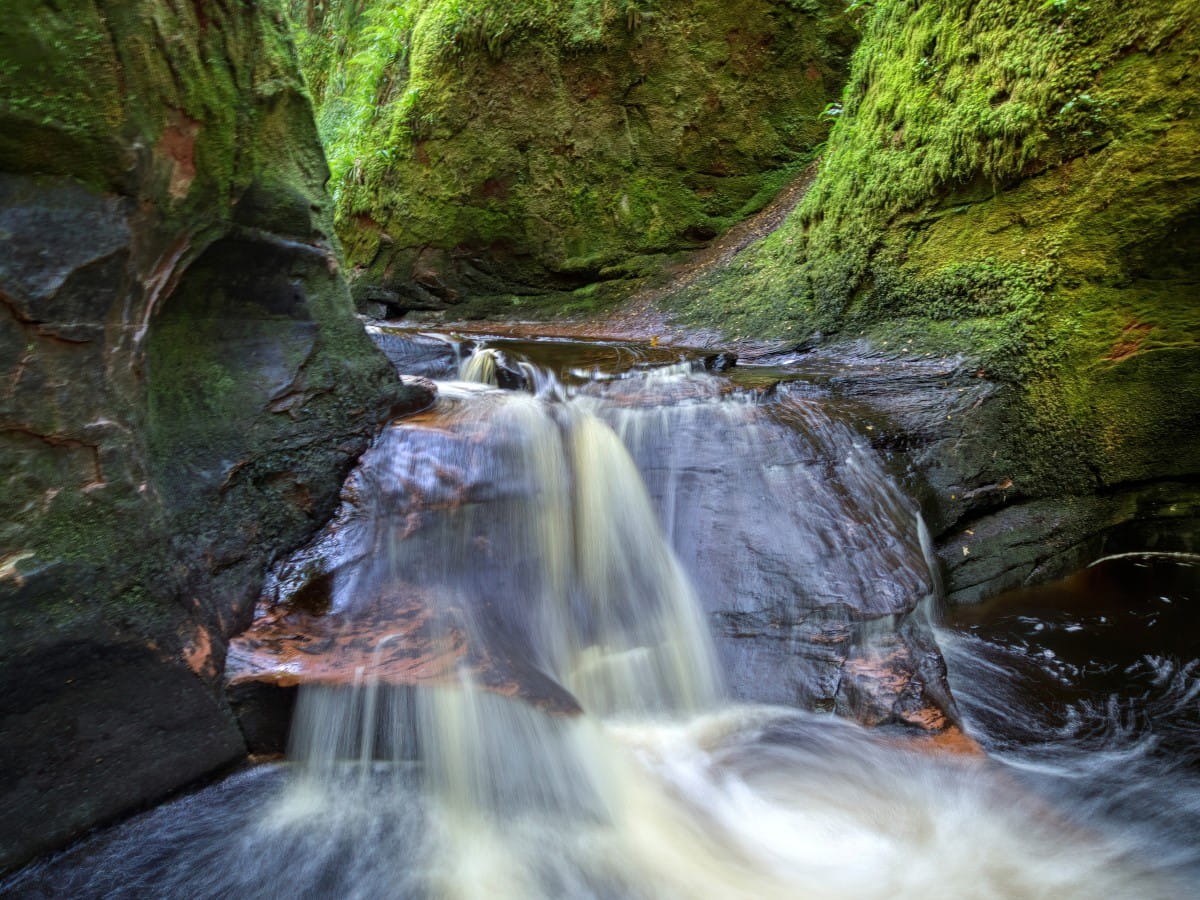
Things to Do Nearby
Burncrooks Reservoir. Address: Blanefield, G63 9AX (Edenmill Farm Shop). Distance: 5.7 miles.
Burncrooks Reservoir is a large body of water set within picturesque countryside. A path circles the reservoir which is part of the long-distance John Muir Way coast-to-coast trail, but it’s possible to enjoy a much shorter route by setting off from the Edenmill Farm Shop.
A small tarmac road connects Burncrooks Reservoir to the equally large Kilmannan Reservoir, which is 0.4 miles south of it.
Loch Lomond. Address: Balloch, Alexandria, G83 8QP (Balloch car park). Distance: 10 miles.
Loch Lomond is the largest loch by surface area in Scotland. There are several places to explore the loch, but a recommended site is Balloch, which has a watersports equipment rental shop next to a shopping centre and an aquarium. To the immediate east, visitors can enjoy the scenic grounds of Balloch Castle Country Park, and an RSPB nature reserve lies a further 3 miles to the north.
The Whangie. Address: Blanefield, G63 9BA (car park). Distance: 3 miles.
The Whangie is an unusual rock formation formed by a deep crevice in the heart of the Kilpatrick Hills. Access is via a rough path from a car park on the A809. The path is rather muddy but short at 1.2 miles; however, there are multiple paths beyond The Whangie around Auchineden Hill for those walkers who would like to extend the route.
Mugdock Country Park. Address: Milngavie, Mugdock, Glasgow, G62 8EL. Distance: 8.6 miles.
Mugdock Country Park is a large country park on the northern edge of Glasgow. The park features several walking trails, a castle, an adventure playpark, cafes, and a shop. There are also regular events staged throughout the year such as guided nature trails and craft workshops.
Glengoyne Distillery. Address: Dumgoyne, Killearn, Glasgow, G63 9LB. Distance: 3.2 miles.
Glengoyne Distillery is nestled at the foot of Dumgoyne Hill around 14 miles north of Glasgow. This traditional distillery has a number of experiences for visitors including whisky tours, tastings, and the ability to create your own single malt in the tasting room.
Frequently Asked Questions
Why is it called the Devil’s Pulpit?
The term ‘Devil’s Pulpit is given to a peculiar mushroom-shaped rock located in the middle of a red sandstone gorge in Finnich Glen near Glasgow.
A local legend says that the rock was used by the devil for sermons, and was, therefore, the devil’s pulpit.
The origins of the myth are believed to stem from the fact that the waters of the Carnock Burn which flows past the rock have a blood-red colour.
How long does it take to do the Devil’s Pulpit?
A complete walk from the car parking area at Finnich Glen to the Devil’s Pulpit and back will take approximately one hour at a leisurely speed with stops for photos.
Why is the Devil’s Pulpit red?
The Finnich Glen gorge including the Devil’s Pulpit is comprised of red sandstone. This sandstone takes on a blood-red colour when wet which in turn causes the waters of the Carnock Burn to appear red.
How deep is the Devil’s Pulpit?
The Devil’s Pulpit refers to a particular rock outcrop of the Finnich Glen gorge, but the name is often used to describe the entire gorge.
The gorge extends for approximately 1,500 feet in between undulating fields so the depth from top to bottom varies between 60 and 100 feet along its length.

